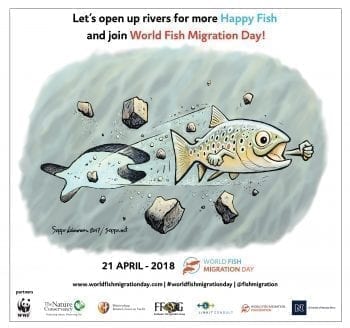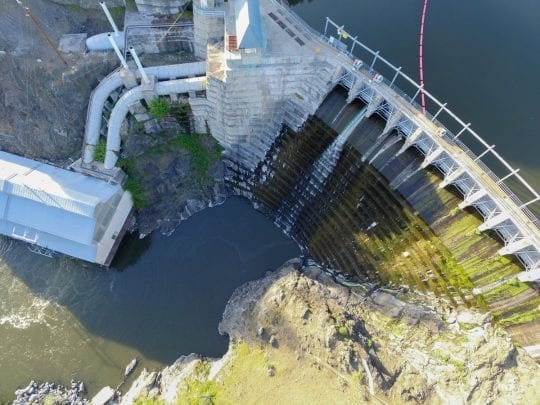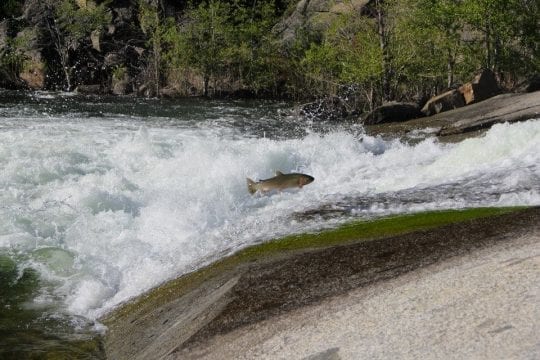Klamath Dam Removal from the Fish’s Perspective
 To celebrate World Fish Migration Day, we’re sharing this creative article written by our own Mike Wier on the removal of Klamath Dams from the perspective of fish. Currently, the Klamath River Renewal Corporation (KRRC) is hosting informational meetings about dam removal and encourage the public to attend as this is best place to hear what’s going on and to ask questions.
To celebrate World Fish Migration Day, we’re sharing this creative article written by our own Mike Wier on the removal of Klamath Dams from the perspective of fish. Currently, the Klamath River Renewal Corporation (KRRC) is hosting informational meetings about dam removal and encourage the public to attend as this is best place to hear what’s going on and to ask questions.
Controversy over Klamath Dams removal has some native fish excited while some local fish remain apprehensive.
By Michael E. Wier
The Klamath Basin is on the verge of what could be the largest river restoration project in the history of the United States, maybe the world. Last year settlements were procured between the dam operating company PacifiCorp and a multitude of other stakeholders (including farmers, tribes, commercial fisherman, local government, and conservationists) to remove four dams on the mainstem Klamath River. After years of negotiations it was decided that retrofitting the dams for new safety standards and updating operational facilities would cost more money for PacifiCorp, rather than forfeiting their license and removing the dams altogether. Funding methods have now been implemented and plans are being drafted to begin the dam removal process as soon as 2020.
Removing the four dams will re-connect over 300 miles of historic habitat that was once accessible to native salmon and steelhead. Isolated tribes of native fish persist high in the tributaries of the downstream reaches of Klamath River. Many of those fish have been waiting patiently for decades for the opportunity to return to their native waters.
Wild Bill, an elder from the last of the winter steelhead tribe and one of the greatest proponents of dam removable commented: “The upper Klamath basin is our ancestral water. We used to have spawning ceremonies in the great springs of the Wood and the Williamson. Now we are stuck in the isolated lower tributaries. Most of these small rivers have snowmelt source waters that are no longer reliable. Our fish brothers and sisters have been suffering. It’s our right to return to the sacred lake and our historic spawning springs.”
Over the past few decades, living conditions in the lower stretches of the river have significantly declined. In some years, algae blooms on the reservoir warmed the water temperatures and depleted oxygen down to lethal levels.
A fall-run Chinook we interviewed a few years back had this to say: “I waited years to be ready for the Fall Spawn Prom. After a couple weeks of Singles Mixers in the estuary, a large group of us decided to head up river for the annual migration ceremony. Things were going good until we hit mid-river. All of the sudden the water started getting really hot and I was having trouble breathing. By that point we were too far up river to turn back. I looked around and a lot of the better-looking hens started losing their eyesight. Everyone started gasping for breath and then went belly up right in front of me. It was like a scene from a zombie horror movie. I didn’t get to spawn at all that year. Needless to say I was bummed, man!”
Many wild salmon and steelhead were completely pushed out of their cold home springs once the dams were installed. However, other fish have since moved into those neighborhoods and taken up permanent residence. If native salmon return, local trout know they will mostly likely be bullied out of the prime feeding lanes.
Mr. Planterton, a trout from below JC Boyle Dam, remarked: “I’m a fifth generation transplant. My grandfather’s grandfather fell from the great truck tank back in 1985. I’ve been stuck in this reach for a long time. I’ve been trying to find a way out of here. How the heck does one get to the ocean from here? I swam up the river and down the river, and back up and down, yet I always just end up in this stupid lake. I really want to see the great ocean, but I am also nervous about running into those giant salmon squach I have heard legends about.”
Many wild fish from across the state of California are very happy about the dams’ removal. It’s exciting to imagine all the new territory to explore.
Even strays from neighboring watersheds are hopeful for the prospect of someday visiting the Cascade Range. One noted: “I’m from the Smith River area, but I’ve always wanted to visit the Klamath. Some strays I ran into a few years back in the ocean school talked about miles of river roads leading to some truly amazing cold springs. As the Smith gets warmer, those cold springs sound better and better. We never imagined it could be possible for an ocean fish to make it out of the coastal range. But rumor has it that once those road blocks come out we’ll be able to make it all the way to the great redband basin and beyond. There’s bound to be some epic cold springs up there.”
However there is still some resistance from local fish who will be most affected by removing the four dams. Stretches of river that were once superhighways for salmon and steelhead have now been filled up behind the dams. All those new warm water housing developments are now occupied by non-native fish who migrated here from other areas looking for a better life.
Billy the Bass commented, “I am a third generation Siskyou bass. My family has been herding crawdads and farming dragonfly larva in the shallows of Irongate as long as I can remember. We’re tough as any bass out there. I’ve heard stories of our Shasta kin having angler-fighting rodeos. They let humans catch them for fun, then they fight their way free. Maybe if more people were paying attention to us, we could have one of those fancy tournaments here. I bet that would bring some human tourists to the area. We sure like to entertain.”
A young wild summer steelhead named Steely Dan responded, “Forget fighting humans. That’s lame. All I need is some frosty bugs and some tasty cold river waves, dude. Once those dams come out I plan to be one of the first steelhead up there. I can make that swim in a couple days. I’ve heard there are still some cute landlocked hens up there. I can’t wait to introduce myself and hopefully dance with some. And if I run into any of those foreign bass, I’ll kick their tales off! That’s my grandfather’s river.”
Whichever way you feel about it, it will be interesting to see the changes along the Klamath River in the coming decade. Exciting times ahead.
Photos by Mike Wier.







1 Comment
FREE THE KLAMATH!